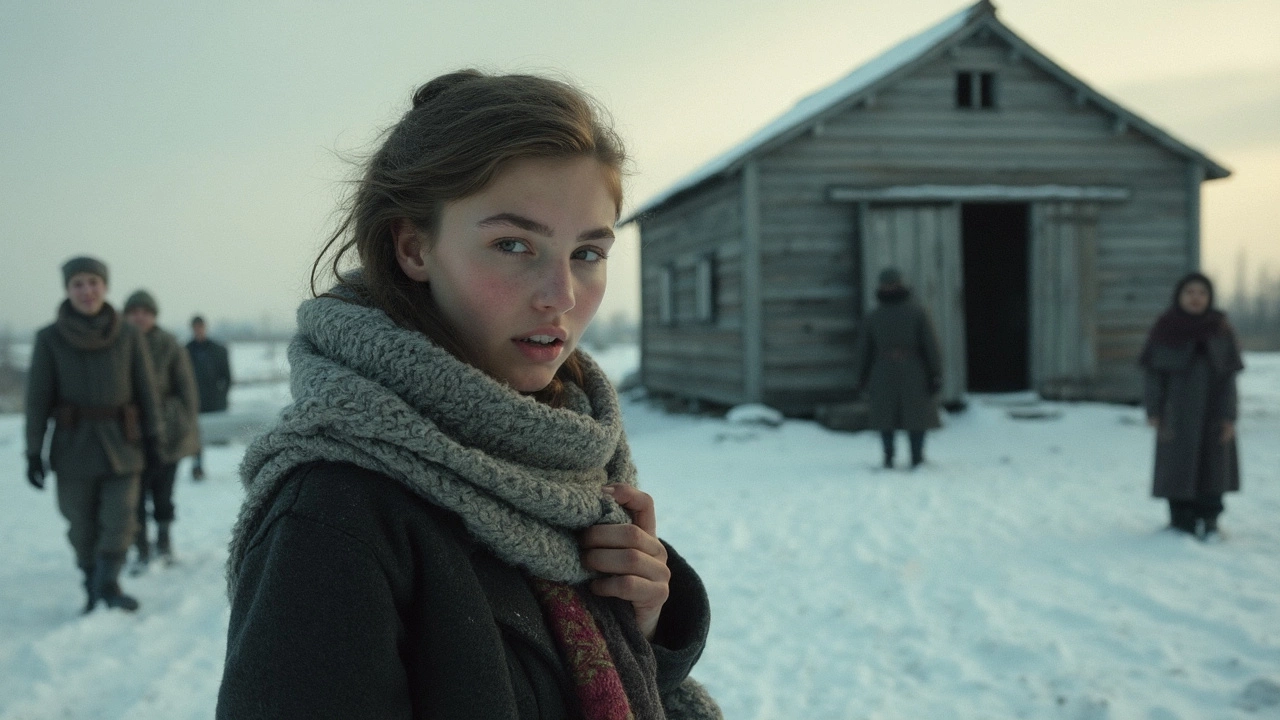Not every romantic novel comes from such a hard slice of history. Between Shades of Gray pulls straight from the life and death struggles faced by thousands of Lithuanians during World War II. The story builds around Lina, a teenage girl, and her family who get ripped from home and thrown into Stalin's labor camps. Talk about a setting for romance that's anything but a walk in the park.
The book doesn’t hide the struggle. Instead, it places young love—and all its risks—right in the middle of one of the darkest periods in Eastern Europe. Why write a romance here? Real people actually fell for each other in these brutal camps. Even as they faced hunger and heartbreak, stories of small joys, hope, and even secret crushes kept folks going when it would’ve been easier to give up.
Want to know the reason the details feel so real? Ruta Sepetys, the author, tracked down survivors and their families to hear their stories. She took their memories and shaped them into Lina’s world. You get both a love story and a crash course in a piece of history most people never hear about in school.
- The Real Events Behind the Story
- How the Author Brought History to Life
- Romance Amid Hardship
- Interesting Facts You Didn't Know
The Real Events Behind the Story
Here’s the thing about Between Shades of Gray: the plot might sound impossible, but the events are based on true stories from the Baltic region during World War II. In 1941, after Stalin took control of Lithuania, Latvia, and Estonia, people who were seen as threats—doctors, teachers, artists, and pretty much anyone smart or outspoken—just disappeared. We’re talking more than 130,000 people yanked from their homes and shoved into cattle cars with barely any notice.
They landed in Siberian labor camps, often somewhere so cold you’d see your breath even in summer. Families got separated. Kids, like Lina in the book, lost everything overnight. The Soviets forced them to do backbreaking work, like farming or mining, and didn’t care much if they lived or died. Why? Stalin thought it was easier to control the region by making an example of its best people. This is where the heart of the book comes from—the Lithuanian deportees’ struggle to hang onto hope, dignity, and love.
If you’re thinking, “Why haven’t I heard about this before?” you’re not alone. The details of these deportations were kept secret for decades. Survivors risked punishment if they spoke up. It wasn’t until after the Soviet Union broke apart in the early ‘90s that people started talking openly. That’s why Ruta Sepetys had to do so much digging for her research and why historical fiction like hers matters.
| Year | Lithuanians Deported |
|---|---|
| 1941 | ~18,000 |
| 1945-1952 | ~118,000 |
So when you read Between Shades of Gray, remember: It’s more than just a romance. You’re stepping into the shoes of thousands who had everything ripped away and had to figure out how to survive, and even find love, in the worst circumstances. It’s a wild story, but it’s all built on what real families like Lina’s actually faced.
How the Author Brought History to Life
Ruta Sepetys didn’t just sit at a desk Googling facts about Soviet labor camps when writing between shades of gray. She packed her bags and traveled to Lithuania to see and listen for herself. She sat down with survivors, some who had been sent away as kids just like Lina in the book. These stories weren’t easy to talk about, but they gave the novel its raw truth.
She even toured old prisons and Siberian camps so she could write exactly what these places felt, sounded, and even smelled like. No outsider guesses here—details like frostbite, the taste of moldy bread, and the constant fear all came from firsthand accounts. One survivor even described what it was like to secretly draw under the nose of Soviet guards, which became a key part of Lina’s character.
Instead of making up background for the camps and journeys, Sepetys worked with historians and checked every minor detail. The “deportation train” scenes match records kept in Lithuanian archives. The list below shows how she kept the facts straight:
- Interviewed over a dozen real-life survivors of Stalinist repression
- Visited former labor and prison camps for accuracy
- Read secret letters and diaries smuggled out of camps
- Partnered with museums and historians in Lithuania
- Double-checked timelines, uniform designs, and language used
Tiny details—like people trading jewelry for a scrap of bread, or hiding love notes—weren’t random. She took all those bits straight from what the survivors shared, which is why the book feels so real. If you ever wondered why between shades of gray gets under your skin, now you know: almost every struggle and hope in the book actually happened to someone.

Romance Amid Hardship
Most people don’t picture a romance novel set in a freezing, Soviet-run labor camp, but that’s part of what makes Between Shades of Gray stand out from other romantic novels. Instead of candlelit dinners, there’s starvation, separation, and a constant threat of death. But in between all that, Lina finds herself drawn to a boy named Andrius. Their relationship isn’t about dramatic declarations—it’s about tiny acts of caring, a stolen piece of bread, or a look that says "I know what you’re feeling." They build trust one hard day at a time.
What’s wild is, Ruta Sepetys didn’t make this stuff up. Survivors of the Lithuanian deportations have talked about couples forming strong bonds in the gulags, even under watch by Soviet soldiers. These weren’t fairy tale romances, but connections built out of pure necessity and hope. People really did pass notes hidden in shoes or risk beatings just to say "I love you" to someone still holding on.
The balance between hope and heartbreak is razor thin. Lina and Andrius’s feelings give the story a softer light, pulling the reader through some grim chapters. Sepetys doesn’t pretend the romance makes everything okay—if anything, it shows how love can help people stay human when everything else falls apart.
- Actual couples formed and sometimes survived together through years in camps.
- Romantic feelings could boost morale, giving prisoners a reason to keep going.
- Lina and Andrius’s romance isn’t graphic or traditional—their bond grows through hardship, showing love can survive anywhere.
And if you’re thinking this is an unlikely setting for a romance, here’s a stat that might surprise you: According to interviews Sepetys did with survivors, around one in five said they met their lifelong partner in a Siberian camp. Not ideal, but talk about finding light in a dark place.
Interesting Facts You Didn't Know
You’d think a book tied to such grim history would stick to cold facts, but between shades of gray is full of wild details you probably haven’t heard before. For example, it’s been translated into over 40 languages, turning what happened in Lithuania into a global story. Not many romance novels about Stalin’s gulags have managed that.
Here’s something not everyone catches: Ruta Sepetys has family roots in Lithuania. She didn’t just research for kicks—her dad actually escaped the Soviet takeover as a kid. This isn’t just storytelling; it’s about honoring the past, especially stories that got buried by Soviet censorship for decades.
Some details in the book, like the drawing in the dirt with a stick or the passing of bread as a secret signal, come straight from interviews with camp survivors. Other moments, like Lina’s obsession with drawing faces, were inspired by real people who used sketches as a way to hold onto hope or record the truth when cameras weren’t allowed.
Ruta Sepetys never set out to write a typical romantic novel. Instead, the romance sneaks up on you in little ways—like hidden letters and looks passed between Lina and Andrius. Nobody’s going to forget the soup scene where a potato means so much more than food.
- Hollywood caught on to the buzz and made a movie based on the book. It’s called “Ashes in the Snow.” Of course, some things changed, but the story’s heart is still there.
- The book has been used in schools, not just for reading but in history classes, opening up conversations about silenced tragedies.
- There’s a real museum in Vilnius, Lithuania, called the Museum of Occupations and Freedom Fights, which inspired some book settings. If you go, you’ll see the kind of prison cells Lina’s family survived.
Just to give you an idea of how serious things got for real families, here’s a quick look at the numbers:
| Fact | Details |
|---|---|
| Estimated Lithuanians Deported (1941-1952) | 130,000+ |
| Deaths in Deportation | Over 28,000 |
| Languages the Book Translated Into | 40+ |
So when you pick up between shades of gray, you’re holding more than a love story—you’re grabbing a piece of real, hidden history that still shapes lives today.

